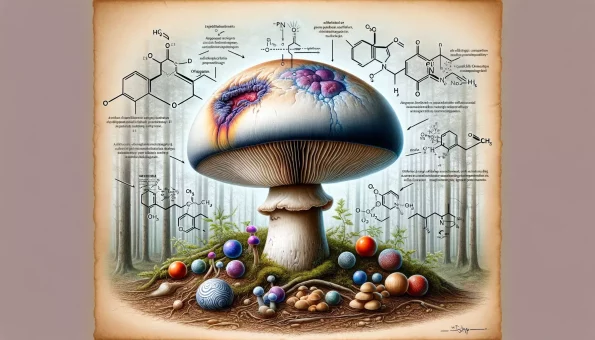Introduction To Blue Shrooms
Blue shrooms occur in a variety of ways and come down to the chemical interactions from external forces. These natural substances change a blue colour as a result of bruising after being picked, trimmed, or pulled carelessly. It’s a natural process that can seem alarming if you don’t know what the blue coloration means.
The tints of blue happen near the bottom of the shrooms after harvesting them from their growth area. Magic mushrooms are abundant living organisms that should be carefully harvested to avoid blue bruising. The bruising disrupts the chemical processes of the mushrooms, leaving many to suggest they are less potent.
Some shrooms are naturally blue, providing psychoactive compounds to users ingesting the substance. When shrooms radically turn blue, it damages the mushroom internally, reaching the middle to the bottom of it. We’ll explain further why magic mushrooms bruise, the science behind it, and get clarity on notable blue mushroom species.
The Science Behind Blue Pigments
The enzymes in the mushroom cells interact with the oxygen and other molecules that make the shrooms turn blue. The interaction is caused by damages within the shrooms, leading to bluish tints. These damages can be from too high heat, hard pressure, trimming aggressively, and other forces that alter the mushroom’s composition.

Within magic mushrooms, psilocin is present, and psilocin has a natural decay when the element is influenced. As mushroom enzymes are affected, they change the mushroom through oxidation, according to Angew Chem Int Ed Engl, on “Injury Triggered Blueing Reactions of Psilocybe “Magic Mushrooms.”
The oxidation influences the psychoactive compounds of the mushrooms, leading to a less potent substance. Blue mushrooms are known to have psychoactive components since they go through chemical reactions to show the blue pigments.
Psilocybin is the active ingredient in mushrooms that can turn into psilocin through chemical reactions resulting in the psychoactive compound.
It’s known that blue shrooms may provide psychoactive compounds for users to experience their uplifting sensations. This isn’t a main indicator, but it can provide a hint to users looking for blue magic mushrooms. There’s not a lot that’s known about why magic mushrooms bruise or turn blue from a scientific perspective.
However, some research suggests shrooms are affected in these ways, and you should take caution in handling them. Not all mushrooms can get blue bruising when handling or harvesting them for personal or medical use.
Why Magic Mushrooms Bruise?
Magic mushrooms bruise if they’re damaged from the outside, leading to a chemical reaction of psilocybin and its enzymes. It shows different types of magic mushrooms containing psilocybin within them. Being careful to extract mushrooms from their natural habitat can provide a potent compound, especially if you want to eat magic mushrooms. However, the more psilocybin a mushroom contains, the more it can bruise easily.
Blue Mushrooms In Nature
Blue magic mushrooms contain myceliums underneath them that appear in fungal threads weaving around each other. This is a network called the mycorrhizal network.
The mycorrhizal network is a vital ecosystem connecting trees and plants that provide a clear communication pathway. They communicate through chemical signals.
According to the National Forest Foundation, “Underground Networking: The Amazing Connections Beneath Your Feet,” they share nutrients among these plants and trees, creating a symbiotic relationship.
Blue Shrooms In Folklore And Culture
Blue mushrooms are known for their psychoactive components and are referred to in folklore for their unique bluish colour. There is some folklore referring to blue mushrooms that have made an impact.
There are also cultures where the blue colour signifies special importance and have created a ritual surrounding it. They believe mushrooms with blue tints have spiritual properties due to the chemical compound they contain. These traditions occurred throughout various countries, including Mexico and Costa Rica.
Notable Blue Mushroom Species
There are dozens of blue mushroom species worldwide that are worth noting.
Here are some notable blue mushroom species:
Lactarius Indigo: This mushroom is wild and found in North America, Europe, and Asia. It contains milk caps on the top and is located in dense forests. They are usually associated with oak, beech, and maple trees.
Entoloma Hochstetteri: The Entoloma mushroom is small, gentle, and has a deep blue colour. It has a deep blue cap with hints of slight green. You can find these in New Zealand, India, and Australia.
Blue Roundhead: This mushroom contains a blue roundhead with a light blue to green coloration. These are found in Ireland and Britain. They can be found often, and it is easy to pinpoint their location.
Hydnellum Cyanopodium: This mushroom is rarely known for its bleeding Bluetooth or blue foot. It grows in the Pacific Northwest area of North America. It contains red drops on the top of the head during the young growth stages.
Terana Caeraulea: Terana Caerulea is a crust fungus containing a bright cobalt blue colour. You can find them in damp forests under logs and branches.
These notable mushrooms are worth looking into for their striking and unique blue coloration. They exhibit natural blue colours and may not have psilocybin present.
Conclusion
Blue mushrooms contain psychoactive compounds like psilocybin and its counterpart, psilocin. The bluish pigments within these mushrooms may alter the potency if they’re damaged from harvest.
The dozens of the strongest magic mushrooms can be interfered with if cut or pressure is put on them. Many users seek magic shrooms for their elevating compound, and having a blue tint can indicate one. Shrooms’ taste can have interesting notes and flavour profiles for you to enjoy if you harvest them correctly.
Are Blue Magic Mushrooms Safe To Consume?
Most blue magic mushrooms are safe to consume, but you should be wary of the ones you can’t eat. Some are poisonous, and you need to identify the type of magic mushrooms they are before consumption.
Where Are Blue Magic Mushrooms Typically Found?
Blue magic mushrooms are typically found in dense forests or near certain trees. They enjoy moist, dense areas of nature.
What Are The Effects Of Blue Magic Mushrooms?
Magic mushrooms’ effects elevate sensations throughout the mind and alter the state of consciousness. You may receive mushroom effects of hallucination, enhanced senses, more creativity, and energy flow, according to the Government of Canada, on “Psilocybin and Psilocin (Magic Mushrooms).”
How Do You Identify Blue Magic Mushrooms?
When looking for magic mushrooms, consider finding them in their natural habitat and look for familiar popular mushrooms. Also, look for blue bruising in magic mushrooms since this can indicate they’re psychoactive. It’s important to be cautious in finding magic mushrooms. They’re not all edible shrooms and may be poisonous.
Can You Use Blue Magic Mushrooms For Medical Purposes?
Yes. You can use blue magic mushrooms for medical purposes. They offer therapeutic benefits to users looking to minimize mental discomfort and enhance daily activities.




